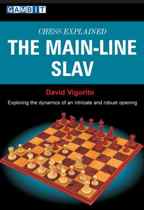Chess Explained — The Main Line Slav
David Vigorito

New England International Master David Vigoritos latest book, Chess Explained: The Main Line Slav, discusses all major lines following the moves 1.d4 d5 2.c4 c6 3.Nf3 Nf6 4.Nc3 dxc4. Following Gambits Chess Explained template, Vigorito uses 25 current, well-annotated games, to illustrate his points.
The material breaks down by chapter as follows:
1 Dutch Variation: White Plays 5.a4 Bf5 6.e3 e6 7.Bxc4 Bb4 8.0-0 0-0 (and 8
…Nbd7) 9.Qe2
2 Dutch Variation: White Plays 5.a4 Bf5 6.e3 e6 7.Bxc4 Bb4 8.0-0 0-0 (and 8…
Nbd7) 9.Nh4
3 Central Variation: Black Plays 5.a4 Bf5 6. Ne5 Nbd7 7 Nxc4 Qc7
4 Central Variation: Black Plays 5.a4 Bf5 6. Ne5 Nbd7 7 Nxc4 Nb6
5 Central Variation: Black Plays 5.a4 Bf5 6.Ne5 e6
6 Black Avoids 5…Bf5: Bronstein (5
Bg4) and Smyslov (5…
Na6) Variations
7 White Avoids 5.a4: The Quiet 5.e3 and the Geller Gambit (5.e4)
Vigorito does a good job of weighing what is important and topical. This explains why the 5… Bf5 Slav gets over two thirds of the book devoted to it with particular attention given to the most challenging variation 6.Ne5. Within this variation he focuses primarily on 6…Nbd7 7.Nxc4 Qc7 8.g3 e5 9.dxe5 Nxe5 10.Bf4 Nfd7 11.Bg2 g5 and the very trendy 6… Nbd7 7.Nxc4 Nb6.
Due to space constraints (it is only 112 pages even if they are oversize), Chess Explained: The Main Line Slav explains this rock-solid and highly popular defense with a wide brush and rarely gets involved in long variations, but that doesnt stop Vigorito from throwing out nuggets. One is offered in the very first game where he explains after 5.a4 Bf5 6.e3 e6 7.Bxc4 Bb4 8.0-0 0-0 9 Qe2 Nbd7 10.e4 Bg6 11.Bd3 Bh5 12.e5 Nd5 13.Nxd5 cxd5 14.Qe3 why Kramnik chose to play 14… Re8 (instead of 14 …Be7) in his match against Topalov.
Chess Explained: The Main Line Slav does not cover all lines of the Slav as Graham Burgess did in his old (2001) but still useful work on the Slav. There is nothing on the Exchange Slav, 4.Qc2, 4.Qb3 or 4.e3 (after 3.Nf3 or 3.Nc3). Fortunately all this material can be found in Play the Semi-Slav (Quality Chess 2008) by the same author.
This book should primarily be useful for players from 1800 to 2400.
